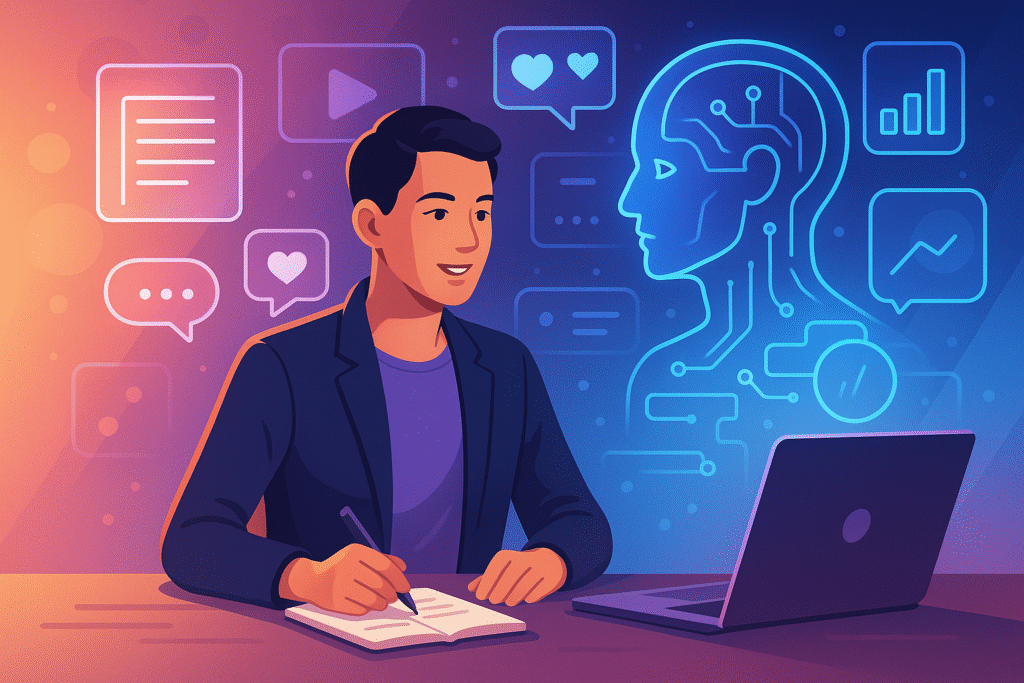“Unlock your personal brand’s potential with AI. Learn how to use AI for personal branding to create content, automate engagement, and grow your audience with powerful, no-code AI tools like ScaleWise AI.”
You want to build a personal brand. It’s a goal many of us share. A strong personal brand can open doors, create opportunities, and establish you as a recognized expert. But let’s be honest, the process is demanding. It requires a constant stream of high-quality content, consistent engagement with your audience, and a deep understanding of what makes them tick. For a long time, this was a manual, time-consuming process. It was a grind.
Then, something shifted. We started to see AI as a futuristic concept and a practical, everyday tool. This isn’t about AI replacing the human element of your brand. Instead, it’s about AI becoming your co-pilot. Your brand assistant. The engine handles the heavy lifting, allowing you to focus on what you do best: being you.
This isn’t a theoretical discussion. This is a practical guide. We’ll explore how you can use AI for personal branding and audience growth. We’ll explore actionable strategies, real-world examples, and the specific tools to transform your approach. This is about working smarter, not just harder.

The Foundation: Your Brand’s North Star
Before we even touch on AI, we must discuss your brand’s core. AI can’t invent your purpose. It can’t define your unique voice or your mission. Those are things that must come from you. So, take a moment. What is your brand’s core message? Who are you trying to help? What problem do you solve? What makes you different?
Think of AI as a powerful magnifying glass. It will amplify whatever you put in front of it. If your foundation is weak, AI will simply amplify that weakness. But AI will amplify your impact exponentially if your foundation is strong, transparent, and authentic.
So, let’s assume you have a clear vision. You know your ‘why.’ Now, let’s explore the ‘how’ with AI.
Chapter 1: The Content Creation Engine – From Idea to Impact
Content is the lifeblood of a personal brand. It’s how you provide value, demonstrate expertise, and build trust. But the constant demand for fresh content can be exhausting. This is where AI truly shines. It can help you generate ideas, write drafts, and repurpose existing material, all at a speed that’s impossible for a human alone.
Idea Generation and Brainstorming
The blank page is a common enemy. You know you need to post something, but what? AI can be a powerful brainstorming partner. You can feed it your core topics and ask it to generate a list of blog post ideas, social media prompts, or video scripts.
For example, if you are a financial advisor, you could ask an AI tool: “Generate 20 blog post ideas for a financial advisor targeting young professionals who want to start investing.” The AI might suggest topics like:
- “The 5-Step Guide to Your First Investment”
- “Investing vs. Saving: What’s the Real Difference?”
- “How to Build a Diversified Portfolio on a Shoestring Budget”
- “Understanding Compound Interest: The Eighth Wonder of the World”
These are not just random suggestions. The AI can pull from vast data to identify common questions and popular topics within your niche. It gives you a starting point. It breaks through the initial inertia.
AI-Powered Content Creation: The First Draft is Never Perfect, But It’s a Start
Once you have an idea, AI can help you write the first draft. Think of it as a writing assistant, not a replacement for your voice. You can provide a few key points, and the AI can structure them into a coherent article.
Give it a prompt like: “Write a 500-word article about the importance of a well-diversified investment portfolio for new investors. Include sections on risk reduction and long-term growth potential. Use a simple, conversational tone.”
The AI will generate a draft. It might not be perfect. The phrasing might be robotic, and the examples might be generic. But it’s a foundation. It’s a lump of clay you can now mold into your creation. Your job is editing, refining, and injecting your personality, unique stories, and specific insights. This is how you avoid a blog that sounds like a machine wrote. You use the machine to get the bulk of the work done and bring the human touch.
Repurposing Content: Maximizing Your Efforts
You just spent hours writing a fantastic blog post. Now what? You can’t just post it and forget about it. A single piece of content can be a goldmine of smaller, bite-sized pieces. Repurposing is a key part of an effective content strategy, but it’s often overlooked because it’s so much work.
AI changes this. You can feed your long-form blog post into an AI and ask it to:
- Create 10 social media posts for platforms like Twitter and LinkedIn, each with a different angle or quote from the article.
- Write a 300-word email newsletter summary that links back to the full post.
- Generate a script for a 60-second video reel highlighting the main takeaways.
- Pull out five key statistics or quotes to be used as visual graphics.
This process multiplies your content output without you having to start from scratch every single time. It ensures your message reaches different audiences on different platforms, all from the same initial effort. This is AI-driven audience growth at its core.
AI for Visuals and Multimedia
Content isn’t just text. It’s images, videos, and graphics. AI tools are now incredibly good at generating visual content. You can use platforms to create unique images based on text prompts.
For example, suppose you’re writing a blog post about the future of finance. In that case, you can ask an AI image generator to create “a stylized image of a futuristic cityscape with financial graphs overlaying it, in the style of a digital painting.” This gives you a custom, high-quality image without needing a graphic designer or relying on generic stock photos.
Video is another area. AI can assist with scriptwriting, creating subtitles, and even generating voiceovers. Some tools can even make simple video clips from your text or images. This means you can make a professional-looking video without a massive budget or a film crew.
Chapter 2: The Engagement Engine – Building Community, Not Just an Audience
A personal brand is not a one-way street. It’s a conversation. It’s about building a community around your ideas. This means responding to comments, engaging in discussions, and being present. This, too, can be a time-consuming part of the process. AI can help you automate these tasks without sacrificing authenticity.
Smart Social Listening and Engagement
How do you know when someone mentions your brand? How do you keep track of all the conversations happening in your niche? Manual monitoring is a chore. AI-powered social listening tools can scan the internet and social media platforms for mentions of your name, your brand, or specific keywords related to your industry.
When a new mention is found, the AI can alert you. This allows you to jump into the conversation and respond quickly. This kind of responsiveness makes your audience feel seen and heard. It shows you’re paying attention.
Automating Your First Response
Imagine you get a hundred comments on a new post. It’s impossible to reply to all of them with a personalized, thoughtful response in a short amount of time. AI can help with this. You can set up AI tools to draft a first-line response to common questions or comments.
For instance, if someone comments, “Great post! Where can I learn more?” an AI tool could automatically reply with a message like, “Thanks for the kind words! You can find more resources on this topic in the link in my bio. Hope to see you there!”
This is not a replacement for human interaction. It’s a way to handle the initial wave of engagement, allowing you to focus your time and energy on the more detailed, meaningful conversations. It’s a way to keep the momentum going.
Creating Intelligent Chatbots for Your Website and DMs
For many personal brands, direct messages and website inquiries are a constant flow of repetitive questions. Think of a chatbot as your 24/7 personal assistant.
You can train an AI chatbot on a specific knowledge base, like your blog posts, FAQs, and product descriptions. When someone visits your website or sends a DM with a standard question, the chatbot can provide an instant, accurate answer.
For example, if you’re a fitness coach and someone asks, “What’s the best workout for beginners?” The chatbot can pull from your blog posts and provide a link to a relevant article. It can answer questions about your services, pricing, or philosophy. This frees you from answering the same questions over and over again and provides a great user experience.
Chapter 3: The Strategy Engine – Using AI-Driven Analytics to Grow
Content and engagement are the ‘what’ and ‘how.’ But strategy is the ‘why’ and ‘when.’ Without a clear plan, you’re just creating content in a vacuum. AI provides powerful analytics that can turn your data into actionable insights, helping you refine your approach and supercharge your growth. This is where AI analytics for branding becomes the key to intelligent decision-making.
Understanding Your Audience: It’s More Than Just Demographics
Most social media platforms give you basic analytics. You can see things like age, gender, and location. But AI can go much deeper. It can analyze the language in your comments and DMs to understand the sentiment of your audience. Are they positive? Negative? What emotions are they expressing?
AI tools can also analyze which topics and content formats resonate most with your followers. It can track which blog posts lead to the most website visits, which social media posts get the most shares, and which videos keep people watching the longest.
With this information, you can stop guessing, create more of the content your audience wants, double down on the working strategies, and abandon the ones that aren’t.
Predictive Analytics: What’s Next for Your Niche?
Knowing what content will go viral before creating it would be great. While AI can’t perfectly predict the future, it can accurately analyze trends. AI tools can monitor news, social media, and search queries to identify emerging topics and keywords in your industry.
For instance, an AI tool might notice a sudden spike in search queries for “sustainable investing” and “crypto and retirement.” This tells you that these are topics people are interested in right now. You can create content around these topics to capitalize on the trend and position yourself as a timely, relevant expert. This proactive approach gives you a significant advantage over competitors who just react to what’s happening.
Optimizing Your Posting Schedule
When is the best time to post? The answer isn’t the same for everyone. It depends entirely on your specific audience and their online habits. AI-powered tools can analyze your audience’s behavior and recommend the optimal times to post on each platform.
It can tell you that your LinkedIn audience is most active at 8:30 AM EST on Tuesdays and Thursdays, while your Instagram audience is more engaged at 7:00 PM EST on weekends. This simple adjustment can lead to a significant increase in reach and engagement. It’s a small change with a substantial impact.
Chapter 4: The ScaleWise AI Advantage – Building Your AI Agent
We’ve discussed what AI can do, but now let’s discuss the ‘how.’ The market is flooded with AI tools, often requiring coding or a deep understanding of technology. What if there was a better way? A way to build your custom AI agent without a single line of code?
This is where ScaleWise AI comes in. It’s a powerful, no-code AI agent creation platform and marketplace designed for individuals and businesses wanting to leverage AI’s power without the technical barriers.
What is an AI Agent?
Think of an AI agent as a digital version of you. It’s an intelligent bot you train to handle specific tasks. It can be trained on your content, voice, and expertise. Your AI agent can educate, engage, and grow your audience effortlessly, 24/7.
How ScaleWise AI Works
The platform is built on a simple, intuitive, no-code interface. Here’s a breakdown of the process:
- Define Your Agent’s Role: First, you decide what you want your AI agent to do. Do you want it to be a content creator, a community manager, a customer service rep, or a lead generation assistant? The possibilities are endless.
- Train Your Agent: This is the most crucial step. You provide the AI agent with your data, including your blog posts, articles, videos, social media content, and podcast transcripts. The more information you provide, the smarter and more “you” the agent becomes. It learns your unique voice, tone, and specific knowledge.
- Deploy and Integrate: Once your agent is trained, you can easily deploy it across multiple platforms. You can embed it on your website as a chatbot, integrate it into your social media DMs, or use it to automate email marketing. It’s a seamless process.
- Monitor and Refine: ScaleWise AI’s beauty is that your agent is always learning. You can monitor its performance and provide feedback to make it even better.
Real-World Examples with ScaleWise AI
- The Content Creator Agent: Imagine you have an AI agent trained on your entire library of blog posts. When you’re ready to create a new post, ask the agent to “generate a blog post outline on AI and personal branding, using my past content as a reference for tone and style.” The agent will create a detailed, on-brand outline in seconds.
- The Engagement Agent: Your AI agent can be set up to monitor your social media channels. When someone asks a question about a topic you’ve covered, the agent can provide an instant, accurate answer, referencing your content. It’s like having a team member dedicated to your social media, but at a fraction of the cost.
- The Lead Generation Agent: Your agent can be designed to qualify leads on your website. When visitors ask about your services, the agent can ask them questions to understand their needs. It can then provide personalized information and schedule a meeting on your calendar.
ScaleWise AI isn’t just another tool. It’s a platform that empowers you to build a custom, intelligent extension of your brand. It takes the abstract concept of AI and makes it a tangible, powerful asset for your brand. It provides the ideal solution for building custom AI agents to educate, engage, and grow their audience effortlessly.
The Future of Personal Branding is a Human-AI Partnership
The fear is that AI will make personal branding impersonal, stripping away the very thing that makes a brand ‘personal’ in the first place. But that’s a misunderstanding of how this technology should be used. AI isn’t meant to replace you. It’s intended to augment you.
Think of it this way: The most successful brands in history have always had a team. A writer, a publicist, a manager, and so on. They had a team to handle the mechanics of the business, so the creative force behind the brand could focus on what mattered most: the vision, the ideas, and the human connection.
AI is your new team. It’s your writer, publicist, data analyst, and community manager. It handles the manual, repetitive tasks, freeing up your time and mental energy to focus on the critical work.
Your job is to be the visionary. Your job is to provide unique insights, personal stories, and authentic voices that no AI can replicate. Your job is to build relationships. AI is the tool that makes all of this possible at a scale and speed that was once unthinkable.
The future of personal branding is not a solo effort. It’s a powerful partnership between you and your AI-powered team.
FAQs: Your Questions Answered
Q: Will using AI make my content sound generic and soulless?
A: Not if you do it right. AI is a tool for creating a first draft or an outline. The final polish, the unique stories, and the personal anecdotes must come from you. Your voice is your most valuable asset. Using AI for the heavy lifting allows you to focus your energy on infusing that voice into the content. The goal is to make the process more efficient, not to replace the human element.
Q: Isn’t AI expensive and only for big companies?
A: No. That’s a common misconception. AI tools have become incredibly accessible and affordable for individuals and small businesses. Platforms like ScaleWise AI are specifically designed to be no-code and intuitive, meaning anyone can create and deploy powerful AI agents without a massive budget or a technical background. The return on investment in time saved and audience growth often far outweighs the cost.
Q: How do I choose the right AI tools for my brand?
A: Start with your most significant pain points. Are you struggling with content ideas? Look for an AI content generator. Is engagement on social media a struggle? Look for an AI social listening or response tool. Do you spend too much time answering repetitive questions? Consider an AI chatbot. The key is to find tools that solve a specific problem and streamline a part of your workflow. The ideal solution is a platform like ScaleWise AI that allows you to build a single, custom agent to handle multiple tasks simultaneously.
Q: Can AI help me with my personal brand’s SEO?
A: Yes. AI can analyze your existing content and suggest keywords you should be targeting. It can help you write meta descriptions and optimized titles for search engines. It can also help you identify content gaps in your niche and generate ideas for articles that are likely to rank well. This makes your content more discoverable, a key part of audience growth.
Q: Is it ethical to use AI for personal branding? Should I disclose that I’m using AI?
A: This is an important question. The ethics of AI are still evolving, but a good rule of thumb is to be transparent when appropriate. If you’re using an AI tool to generate a first draft, announcing it is unnecessary. After all, a ghostwriter doesn’t get credit on the book cover. However, if you are deploying a fully autonomous AI agent to interact with your audience, letting people know they are talking to a bot is a good practice. For example, you could say, “This is an AI assistant, but I’ll be jumping in to help with more complex questions!” This builds trust and sets clear expectations. The key is to use AI to serve your audience better, not to deceive them.





